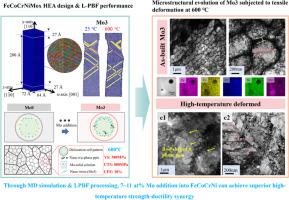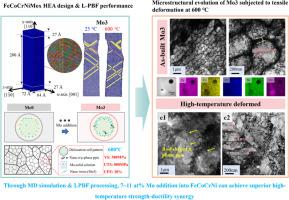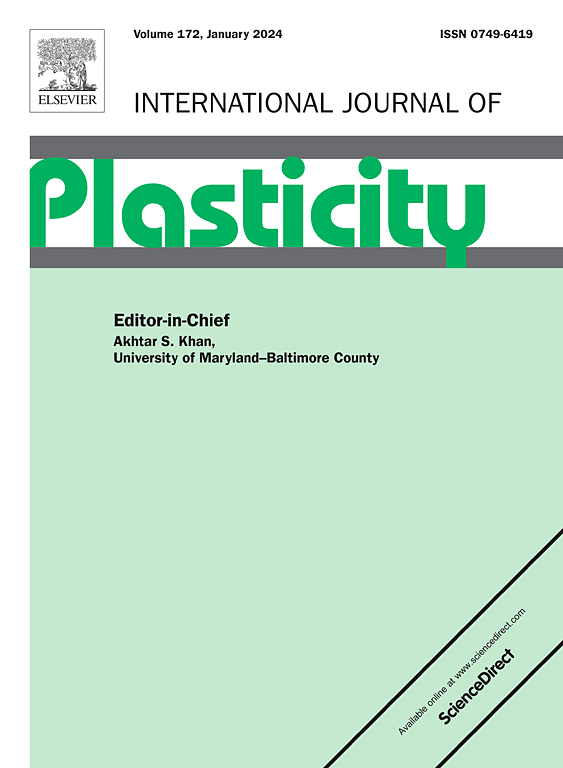Multiscale plastic deformation in additively manufactured FeCoCrNiMox high-entropy alloys to achieve strength–ductility synergy at elevated temperatures
IF 9.4
1区 材料科学
Q1 ENGINEERING, MECHANICAL
引用次数: 0
Abstract
The application of structural metals in extreme environments necessitates materials with superior mechanical properties. Mo-doped FeCoCrNi high-entropy alloys (HEAs) have emerged as potential candidates for use in such demanding environments. This study investigates the high-temperature performance of FeCoCrNiMox HEAs with varying Mo contents (x = 0, 0.1, 0.3, and 0.5) prepared by laser powder bed fusion additive manufacturing. The mechanical properties were evaluated at room and 600 °C temperatures, and the microstructures were characterized using scanning electron microscopy, electron backscatter diffraction, energy dispersive X-ray spectroscopy, and transmission electron microscopy. The intrinsic dislocation cell patterning, solid-solution strengthening, nanoprecipitation, and twinning effects collectively modulated the plastic deformation behavior of the samples. The high-temperature mechanical performance was comprehensively analyzed in conjunction with ab initio calculations and molecular dynamics simulations to reveal the origin of the experimentally observed strength–ductility synergy of FeCoCrNiMo0.3. This study has significant implications for FeCoCrNiMox HEAs and extends our understanding of the structural origins of the exceptional mechanical properties of additively manufactured HEAs.


在添加式制造的铁钴铬镍莫合金高熵合金中进行多尺度塑性变形,以实现高温下的强度-电导率协同效应
要在极端环境中应用结构金属,就必须使用具有优异机械性能的材料。掺杂钼的铁钴铬镍高熵合金 (HEA) 已成为可用于此类苛刻环境的潜在候选材料。本研究探讨了通过激光粉末床熔融快速成型技术制备的不同钼含量(x = 0、0.1、0.3 和 0.5)的铁钴铬镍钼氧化物高熵合金的高温性能。采用扫描电子显微镜、电子反向散射衍射、能量色散 X 射线光谱和透射电子显微镜对微结构进行了表征。固有位错晶胞图案化、固溶强化、纳米沉淀和孪晶效应共同调节了样品的塑性变形行为。结合 ab initio 计算和分子动力学模拟对高温力学性能进行了全面分析,揭示了实验观察到的 FeCoCrNiMo0.3 强度-电导率协同作用的起源。这项研究对 FeCoCrNiMox HEAs 具有重要意义,并扩展了我们对添加制造 HEAs 特殊机械性能的结构起源的理解。
本文章由计算机程序翻译,如有差异,请以英文原文为准。
求助全文
约1分钟内获得全文
求助全文
来源期刊

International Journal of Plasticity
工程技术-材料科学:综合
CiteScore
15.30
自引率
26.50%
发文量
256
审稿时长
46 days
期刊介绍:
International Journal of Plasticity aims to present original research encompassing all facets of plastic deformation, damage, and fracture behavior in both isotropic and anisotropic solids. This includes exploring the thermodynamics of plasticity and fracture, continuum theory, and macroscopic as well as microscopic phenomena.
Topics of interest span the plastic behavior of single crystals and polycrystalline metals, ceramics, rocks, soils, composites, nanocrystalline and microelectronics materials, shape memory alloys, ferroelectric ceramics, thin films, and polymers. Additionally, the journal covers plasticity aspects of failure and fracture mechanics. Contributions involving significant experimental, numerical, or theoretical advancements that enhance the understanding of the plastic behavior of solids are particularly valued. Papers addressing the modeling of finite nonlinear elastic deformation, bearing similarities to the modeling of plastic deformation, are also welcomed.
 求助内容:
求助内容: 应助结果提醒方式:
应助结果提醒方式:


